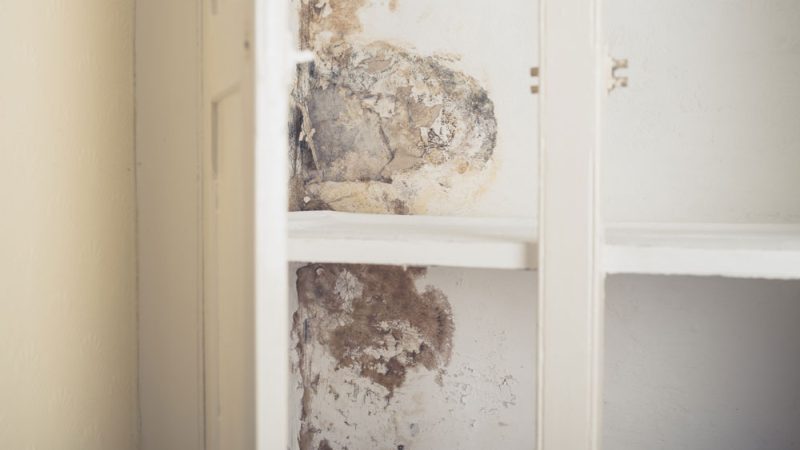Mould in wardrobes is a common yet troubling issue that can affect both the appearance and functionality of your clothing storage space. This problem often arises from excess moisture, inadequate ventilation, or even hidden leaks, and it can lead to unpleasant odours, potential health hazards, and damage to your clothes. Addressing mould promptly is crucial to maintaining a healthy and hygienic wardrobe environment. In this article, we’ll explore ten powerful solutions to eliminate mould in your wardrobe fast, ensuring that your clothes and belongings remain safe and fresh.
Mould in Wardrobe: Identify the Source of Moisture
Before tackling mould in your wardrobe, it’s essential to identify and address the source of moisture. Common causes include high humidity, leaks from plumbing or roofing, and poor ventilation. To locate the source, inspect your wardrobe and surrounding areas for any signs of water damage or dampness. Once you’ve identified the problem, fix the issue—whether it’s repairing leaks, using a dehumidifier, or improving ventilation. Addressing the root cause is key to preventing mould from returning.
Mould in Wardrobe: Remove and Clean Affected Items
Start by removing all items from your wardrobe. This includes clothing, shoes, accessories, and any other items stored inside. Carefully inspect each item for signs of mould. For clothing and fabrics, wash them according to the manufacturer’s instructions, using a hot water cycle if possible. You may also use a vinegar solution or a specialised mould remover for stubborn stains. Ensure that everything is thoroughly dried before returning it to the wardrobe to avoid residual moisture.
Mould in Wardrobe: Clean the Wardrobe Interior
Once the items are removed, focus on cleaning the interior of your wardrobe. Use a mixture of water and mild detergent to scrub the surfaces where mould is visible. For more stubborn mould, a solution of equal parts water and white vinegar or a commercial mould cleaner can be effective. Make sure to wear gloves and a mask to protect yourself from mould spores. After cleaning, thoroughly dry the interior with a clean cloth or towel. Proper drying is crucial to prevent mould from returning.
Mould in Wardrobe: Use Dehumidifiers
Dehumidifiers are excellent tools for managing humidity levels and preventing mould growth. Place a dehumidifier in the room where your wardrobe is located to reduce moisture in the air. This will help keep the environment dry and discourage mould from forming. Ensure that the dehumidifier is appropriately sized for the space and empty its water reservoir regularly to maintain its effectiveness.
Mould in Wardrobe: Improve Ventilation
Good ventilation is key to preventing mould growth. Ensure that your wardrobe has adequate airflow by installing ventilation systems or using an air purifier. If possible, leave the wardrobe doors open occasionally to allow fresh air circulation. Additionally, consider using a small fan to improve air circulation in the room. Proper ventilation helps reduce humidity levels and keeps mould at bay.
Use Mould-Resistant Products
Mould-resistant products can provide an extra layer of protection for your wardrobe. Consider using mould-resistant paints or coatings on the interior surfaces of your wardrobe. These products are designed to inhibit mould growth and are especially useful in areas prone to high humidity. Additionally, mould-resistant bags or storage containers can help protect your clothing and other items from mould damage.
Apply Baking Soda
Baking soda is a natural and effective remedy for combating mould. Sprinkle baking soda on the affected areas of your wardrobe and let it sit for several hours or overnight. The baking soda will help absorb moisture and neutralise odours. Afterward, vacuum the baking soda thoroughly to remove it from the surfaces. Repeat this process as needed to keep mould at bay.
Use Activated Charcoal
Activated charcoal is another effective solution for managing moisture and mould. Place containers of activated charcoal inside your wardrobe to absorb excess moisture and neutralise any musty smells. Activated charcoal is highly porous and can trap moisture and impurities, making it a useful tool for maintaining a dry and fresh-smelling wardrobe.
Mould in Wardrobe: Employ Essential Oils
Certain essential oils possess antifungal properties that can help combat mould. Tea tree oil, lavender oil, and eucalyptus oil are known for their mould-fighting abilities. Mix a few drops of your chosen essential oil with water and spray the solution on the affected areas of your wardrobe. Essential oils can help eliminate mould spores and leave a pleasant fragrance behind. Be sure to allow the area to dry completely after application.
Regular Maintenance and Inspection
Preventing mould from reoccurring involves regular maintenance and inspection. Periodically check your wardrobe for any signs of moisture or mould. Ensure that ventilation systems are functioning properly and that the space remains dry. Regularly clean and vacuum the wardrobe interior to remove dust and potential mould spores. By staying vigilant and proactive, you can keep your wardrobe mould-free and ensure that your clothes and belongings remain in excellent condition.
Conclusion
Mould in wardrobe spaces can be a significant issue, but with these ten powerful solutions, you can eliminate it quickly and effectively. By addressing the source of moisture, using dehumidifiers, and applying mould-resistant products, you can maintain a clean and healthy wardrobe environment. Regular maintenance and proactive measures are key to preventing mould in wardrobe areas from returning. Follow these tips to keep your wardrobe fresh, safe, and mould-free.
FAQs
1. What causes mould in wardrobe spaces?
Mould in wardrobe spaces is typically caused by excess moisture or high humidity. Common contributors include water leaks, poor ventilation, and damp conditions. Addressing these issues is essential for preventing mould in wardrobe areas.
2. How can I prevent mould in my wardrobe?
To prevent mould in your wardrobe, ensure proper ventilation, use dehumidifiers to control humidity, and maintain a dry environment. Regularly inspect and clean your wardrobe to catch and address any signs of moisture or mould early.
3. What should I do if I discover mould in my wardrobe?
If you discover mould in your wardrobe, start by removing and cleaning affected items. Then, clean the wardrobe interior with a mould-resistant solution and ensure it is thoroughly dried. Using dehumidifiers and improving ventilation will help prevent further mould growth.
4. Is it safe to use bleach to remove mould in my wardrobe?
Bleach can be effective in removing mould, but it may not be suitable for all surfaces and can damage wood or fabric. For mould in your wardrobe, it’s often better to use milder solutions like vinegar or commercial mould cleaners and test a small area first.
5. How frequently should I check for mould in my wardrobe?
Regular inspections are important for managing mould in your wardrobe. Check for signs of mould every few months, especially in areas prone to high humidity. Regular checks help catch and address mould issues before they become more serious.
Also read: Acer in Pots: 10 Gorgeous Arrangements for Instant Garden Glamour









